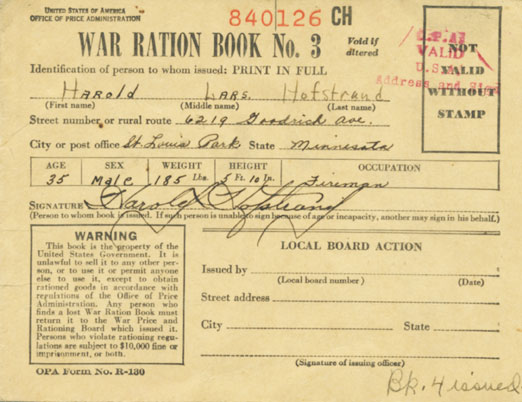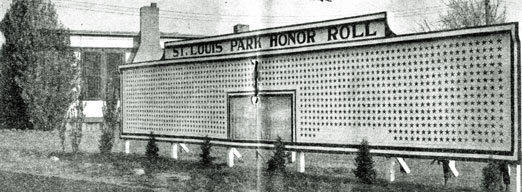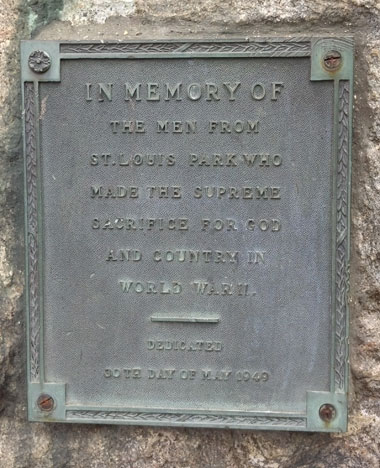As the sons and daughters of the Park went off to war as soon as they were able, the rest of the Village did their best to conserve resources and raise money. Any additional stories are surely appreciated; please contact us. Also see Park in Times of War
HEEDING THE CALL
Countless men and women from St. Louis Park served in the armed forces or in war-related industries during the War.
Draft Board Local 423 was located in Hopkins, although Park men registered at registration points in town. On Valentine’s Day 1942, 737 men between ages 20 and 40 registered for duty at the Village Hall. It was the third group of registrants in the Park. The fourth registration yielded a “disappointing” 120 men, all age 20. Future registrations would call 19 year olds, then 18.
Women also joined the armed forces, although in much smaller numbers. One notable servicewoman was Yvonne Jeannette Demeules (a daughter of Lydia Rogers), who graduated from St. Louis Park High School in 1940. She informally changed her name to Mitzi Rogers in 1925 and changed it legally when she went into the Marines. She served in California and Hawaii during the War, and worked as a court reporter during war crimes proceedings in Heidelberg, where she met her husband, Balthazar Hubertus “Pinky” Pinckaers, who was Dutch.
ON THE HOMEFRONT
The St. Louis Park Commodity Allocation Board “For Tires, Tubes, Autos, Sugar, Etc., Ration Board No. 27-4” was chaired by S. Earl Ainsworth; the other members were Lydia Rogers and Willis H. Richardson. Below is a ration book from 1943.
Scores of citizens were saving on rubber by riding bicycles; in July 1942, over 400 bicycle licenses had been issued.
The St. Louis Park Red Cross was headed by Production Chairman Mrs. G. Andrus, and taught surgical dressing classes at the American Legion Hall.
The “boys” at Republic Creosoting worked an extra half day on a Saturday in 1942, donating their pay to the Red Cross. The effort yielded $367.46.
At the Triangle across from Brookside Drug, behind the gas station, was the local scrap metal depository, which also, for some reason, collected balls of string. Throughout the Park, 300 tons of scrap were collected during a national drive. A message from Mayor Martin in October 1942 thanked everyone who participated in the scrap drive, but added,
It is quite regrettable that one automobile driver had to be apprehended and made to unload scrap from his car after taking it from the stock pile. Evidently he misconstrued the purpose of the drive. Let it be known that anyone tampering with these stock piles will be properly dealt with.
Park students conducted a “soap for soldiers” campaign and collected 750 bars of soap.
In 1944 the staff of the Echowan cited a shortage of film and asked students to bring in their snapshots for the yearbook.
In January 1943 the Echo reported that the U of M offered accelerated courses for girls in order to fill manpower shortages. Courses included:
- Journalism – 2 years
- Technical – Xray, radio, electronics, Army Signal Corpos, technical research – 1 year
- Social Work – 2 years
- Statistical – personal, business, psychology, sociology – 1 year
- Office – typing, shorthand, accounting – 1 year
Despite Minnesota’s inland location, it still participated in Civil Defense activities. Please see that page for details.
While only $45,000 of the $60,000 goal was raised in the first bond drive, the second drive promised that if the Park buys $125,000 in bonds, a bomber would be named after the Village. The response was so great that the ante went up to $175,000, and the total amount raised was $220,000. Sure enough, the “Spirit of St. Louis Park” Mitchell bomber was produced.
THOSE WHO SERVED
During the War, a large billboard, called the Service Honor Roll, was erected just west of the American Legion Hall. It was the project of a committee of businessmen and the Legion. A star was added for each member of the armed forces from St. Louis Park, and names were listed on an enclosed case on the sign.
The 1945 directory provided a photo of the Honor Roll, and listed the names of all 1,053 men and women who served in the War from Park.
Click Here to download a pdf file listing all of the names on the Honor Roll.
These are the names of the 45 men from St. Louis Park who died while serving our country during World War II, as listed on the Honor Roll:
Anderson, Arvid E., Pvt.
Arneson, Albert
Bartholow Gale, Corp.
Bates, Thomas, Lt.
Berkwitz, Sanford B., Pvt.
Carriers, Robt. E., S/Sgt.
Christenson, Paul, Pfc.
Cory, George, Pvt.
Eckers, Richard, Pfc.
Elliot, Warren D., Ens.
Felber, Ted, Pfc.
Freiborg, Herman, Pfc.
Galloway, Leonard, Sgt.
Gary, Paul, EM l/c
Goforth, Richard Lee, S I / c
Greathouse, John, Lt.
Hansen, Clarence, Sgt.
Hogan, Donald, S/Sgt.
Johnson, Donald
King, Stanley, Pvt.
Klatt, Roland, Pvt.
Kleist, Eugene J., Pvt.
Lee, Walter, Pfc.
Lyons, Robert I., Lt.
Marcy, Richard, Lt.
Mclntyre, Robert, Tech. Sgt.
McLean, Roger, S/Sgt.
Mickelsen, Henry E., Lt.
North, Willis, Lt.
0’Neill, Tommy, Pfc.
Opheim, Robert, Pvt.
Prewitt, George G., Corp.
Proebstle, Ray, Capt.
Putnam, Richard H., Corp.
Schroeder, Joseph R., Capt.
Shepardson, Harry, Sgt.
Strubel, Walter R.
Swanson, Donald (Bud), Pvt.
Swenson, Merton F., Lt.
Treutmiller, David, Pvt.
VonBlechen, John H.
Weitzel, Richard J., Lt.
Whitfield, Frederick James, Ens.
Wickman, Earl, Pfc.
Zimmerman, Owen, Sgt.
The Honor Roll also listed 34 men who returned with serious disabilities.
An article in the Dispatch dated September 12, 1947, reported that the committee would reconvene to decide how to dispose of the project. “Certain veterans, feeling that the war is now over,” called on Joseph Justad, chairman of the committee, asking him to remove it.
READJUSTMENT
The May 15, 1945, Echo reported that 2,675 decks of playing cards were collected, presumably for servicemen still waiting to come home.
The June 9, 1945, issue of the SLP Spectator reported that plans were made to assist returning servicemen in their readjustment to civilian life. Mayor O.B. Erickson and representatives of the American Legion and the War Dads established committees on education, finance, and rehabilitation to aid the veterans.
Twenty emergency housing units for veterans housing were allotted to the Park in May 1946.
Postwar organizations listed in the 1946 Directory included:
The War Dads of St. Louis Park met at the Village Hall. Officers were Herman J. Bolmgren, Jake A. Werner, and Lew Conley.
American War Mothers, Donald Johnson Chapter was chartered on August 23, 1946 with 14 members. The purpose of the group, the ninth such group in Minnesota, was to providing aid to Veterans’ Hospitals by making items for the patients and helping out at the hospital. They also had a goal of have a war mother present at the peace tables of WWII. Membership was limited to the “blood mothers of sons and daughters in service.” President was Mrs. Mary Johnson, whose son, an AAF tail gunner, died in a B-24 over Dortmund Germany on January 28th, 1945. The group was active until at least 1958, selling carnations to raise money for disabled and hospitalized veterans.
The International Sunshine Society worked “in the Veterans’ Hospital and the University Hospital, made layettes and remembered patients in hospitals at holiday time and on birthdays.” President was Mrs. C.H. Dahl.
Gold Star War Kin, a nationwide organization, was founded in 1945 by Morton Arneson and Harry R. Bates. The statewide meeting was held on November 6, 1945.
Jewish War Veterans of St. Louis Park
For memoirs written by men from St. Louis Park who served during the war, see the last chapter of Something in the Water.
Plaque placed by the American Legion on May 30, 1949, on rock located near the Veterans’ Memorial Amphitheater in Wolfe Park.




